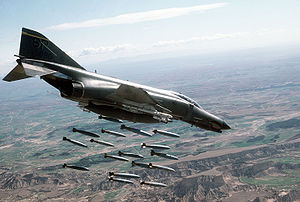
Back حرب جوية Arabic Guerra aérea AST Guerra aèria Catalan شەڕی ئاسمانی CKB Rhyfela awyrennol Welsh Luftkrieg German Guerra aérea Spanish Aireko gerra Basque رزم هوایی Persian Ilmasodankäynti Finnish

| Part of a series on |
| War |
|---|
Aerial warfare is the use of military aircraft and other flying machines in warfare. Aerial warfare includes bombers attacking enemy installations or a concentration of enemy troops or strategic targets; fighter aircraft battling for control of airspace; attack aircraft engaging in close air support against ground targets; naval aviation flying against sea and nearby land targets; gliders, helicopters and other aircraft to carry airborne forces such as paratroopers; aerial refueling tankers to extend operation time or range; and military transport aircraft to move cargo and personnel.[1]
Historically, military aircraft have included lighter-than-air balloons carrying artillery observers; lighter-than-air airships for bombing cities; various sorts of reconnaissance, surveillance, and early warning aircraft carrying observers, cameras, and radar equipment; torpedo bombers to attack enemy vessels; and military air-sea rescue aircraft for saving downed airmen. Modern aerial warfare includes missiles and unmanned aerial vehicles. Surface forces are likely to respond to enemy air activity with anti-aircraft warfare.
- ^ See John Andreas Olsen, ed., A History of Air Warfare (2010) for global coverage since 1900.
© MMXXIII Rich X Search. We shall prevail. All rights reserved. Rich X Search